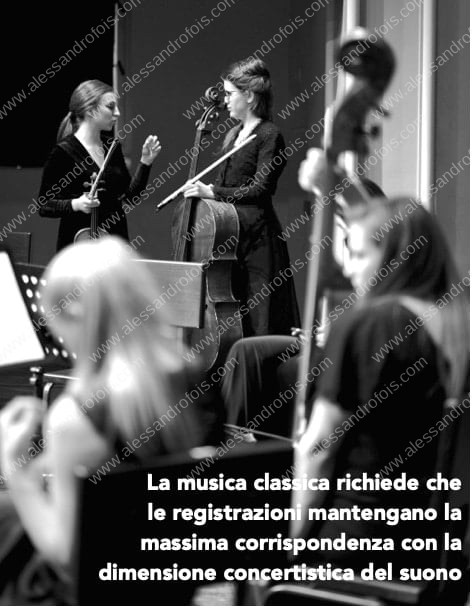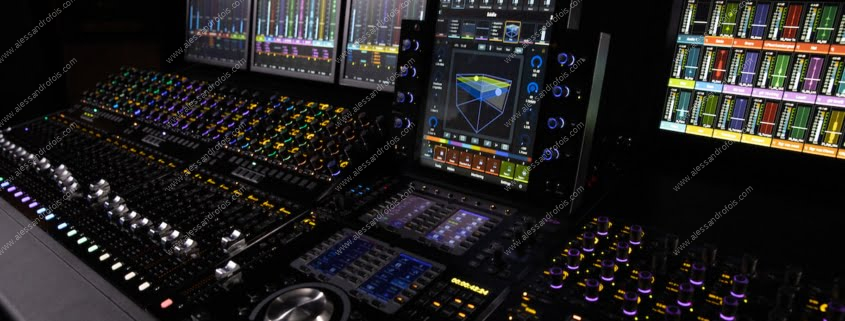The mental approach to effective audio mixing
- Author Profile
- Recent posts
Pianist, Composer, Arranger, Sound Engineer, Writer, Blogger
Alessandro Fois is a musician, composer, pianist, arranger and sound engineer. Since 2018, he has also been a writer, blogger and webmaster. He currently resides in Ivrea (Turin) where, in addition to the above activities, he manages Lycnos, studio for audio, video and web services, and the recording studio Glamour Recording Studio.
Foreword: What is audio mixing for?
Many might take the answer to this question for granted. However, both during some seminars and in conversations with various industry professionals, I have come across numerous misunderstandings regarding the true intentions of mixing. Consequently, I will try to condense in this space what, in my opinion, are the fundamentals of mixing.
Before diving into this topic, it is essential to emphasise a key aspect that not everyone seems to fully understand: the quality of musical interpretations is the pillar on which sound success is based, even before the mixing stage.
By 'quality of interpretation' I am referring to:
- The use of high quality musical instruments, masterfully tuned to eliminate any acoustic imperfections, such as tonal dominants, frequency deficiencies or discontinuities, precise tuning, dynamic balance and the elimination of mechanical noises related to performance, with the use of new, good quality strings or skins.
- Accuracy of execution regarding tempo, poise and dynamic-expressive modulation.
- The pathos conveyed by the artists during the performances.
Note
Although it seems obvious, it should be made clear that the above-mentioned problems cannot be solved during the mixing phase, to which problems even the interventions of the most experienced and qualified sound engineers can only bring marginal improvement. In order to achieve a high-quality product, it is essential that both the musical performances and the preparation of the instruments have been performed with extreme precision and care, as technical miracles are not possible.
It is also vital to understand that although mixing can refine the sound, it does not have the ability to alter the performance approach or radically transform the timbre of one instrument into another with different and distinct sonic characteristics. For example, it will not be possible to convert the timbre of a jazz drum kit into one that is suitable for heavy metal, nor will a jazz performance technique be able to emulate a typical rock sound.
Therefore, it is imperative that the sound engineer promptly clarifies such limitations with musicians, especially less experienced ones, before embarking on unfeasible challenges destined to generate disappointing results.
This implies that artistic and sound decisions that have a significant impact on the overall tone and identity of a mix must be made before or during the recording stages, rather than during the mixing itself.
Definitions and Functions of Mixing
Mixing can basically be defined as a process where multi-track audio material, whether recorded, sampled or synthesised, is balanced, processed and finally merged into a mix to generate an audio product that is accessible to both end consumers and the recording industry. This product may be presented in multi-channel audio formats or, more commonly, in stereo, and recorded on digital (magnetic tape files, CDs or memory devices) or analogue (magnetic tape or vinyl) media.
A more accessible but equally crucial definition of mixing would be the following:
"The message must allow for the manifestation of emotions and creative ideas of a musical nature through the high quality performances that convey them".
Given the significant role of the mix in determining the success of an album or single, we can state that:
- a quality mix can intensify the emotional impact of a piece of music, making it more appealing and increasing its chances of popular resonance;
- a badly executed mix has the power to deteriorate a high-value piece and severely limit its prospects of success.
With the increased use of high-quality earphones, a wide range of listeners have developed an appreciation for sound quality, making sound quality a fundamental requirement of a mix. This is achieved by reducing sound masking, improving definition, enhancing dynamics, balancing tonal balance and volumes, and so on.
The four basic technical functions of mixing can be outlined as follows:
- Corrective Function:
- Correcting and resolving tonal and dynamic imperfections in instruments.
- Reduce performers' errors related to intonation, timing and those resulting from the low interaction (interplay) that occurs during multitrack recordings (i.e. when not all singing and playing together, but rather proceeding in pieces).
- Acoustic function:
- Reduce acoustic and environmental problems that arose during recording.
- Optimising function:
- Improve the quality of recorded sounds through the appropriate use of tone, dynamics and environment simulation processors.
- Creative Function:
- Contributing to the sound alchemy outlined by the musicians, enhancing the music, the performance intention, the expression of the piece and introducing unique and distinctive sounds, whenever possible.
Each function plays a crucially different role in the mixing process, each helping to refine and enhance the final sonic representation of the song or album.
Art and Technique of Mixing
There are those who make the mistake of perceiving mixing exclusively as a purely technical task, considering it in this sense a mere routine intervention; some go even further, seeing it merely as a means to correct and recover faulty recordings.
It is undeniable that mixing involves the application of numerous techniques: balancing volumes, taming uneven dynamics and correcting inappropriate frequencies are just some of the challenges a sound engineer will face.
However, it is good to know that, with disciplined training, most people can acquire sufficient mastery of the technical practice of mixing; it is like saying that, after 'compressing' or 'equalising' hundreds of different audio tracks, anyone should be able to perform this task with a certain level of competence.
But it is crucial to understand that mixing goes beyond mere technique; it is an art where intuition and creativity play a crucial role in interpreting and enhancing the emotional message and artistic intention of the song, blending them into a cohesive and expressive harmony.
How, then, can one make a quantum leap in approaching mixing?
Dreaming of the mix
Having a prior vision of the mix in mind certainly constitutes one of the main differences between the beginner and the expert: whereas the beginner models sounds by trial and error, the expert first imagines them and then realises them more or less expeditiously during the mixing operations, setting the technical controls with confidence.
Technical skills are very important but can be acquired: the real essence of mixing, which is its 'artistic' component, however, does not lie in these skills. Many mixes are technically excellent, but nothing more; similarly, many mixes may not be technically flawless, but as a listening experience they are 'breathtaking'.
We can say that it is a bit like a musical performer: it is because of the inherent creativity that goes far beyond technical balance that some mixes are highly acclaimed and their creators considered 'visionary masters' of sound. The non-technical side of mixing involves creating the overall sonority that envelops the music: shaping the sounds, defining the 'acoustic horizons', coordinating the harmony between the elements of the soundscape and building a soundscape of high emotional impact. It all depends on the creative decisions, talent and 'overall vision' of each sound engineer: each choice will have a profound influence on how the music will be perceived by the listener.
This vision can then be translated into practice through the equalisation we set, the reverb we choose, the incisiveness of the transients we determine with the compressor, and so on. Quite simply: there is no right or wrong way of doing things, and therefore the standard technical information that one acquires with experience can certainly be useful for orientation, but the path to follow must be decided and traced by each sound engineer on his own, according to his own nature.
An acoustic guitar, a bass drum or any other instrument can be tuned in many different ways and all could be considered technically correct, but in various contexts some will be more interesting than others. A mix is like a photographic portrait of music: many different shots will always represent the same subject, but only certain shots and certain 'cuts of light' will have 'charm', and certainly one of them will have more than the others. An excellent mix is both an art of sound and of communication.
A 'mixing engineer' is therefore called upon to become a 'sound artist', because mixing is technique, but it is also art.
One of the functions of the mixing engineer, as well as his great responsibility, is to help convey the emotional message contained in a piece of music, enhancing it; this is the first notion to acquire in order to favour the right approach to the mix. From the overall plan of the mix down to the tiniest nuances of reverb, an inspired use of the technical and expressive tools at the engineer's disposal can enhance or sometimes even create suggestions of power, aggression, softness, melancholy and many others; or it can destroy or hinder the emotion created by the performers, trivialising and obfuscating it.
It is therefore necessary to understand that mixing is not just a set of technical challenges, but a process aimed at converging towards an overall vision of the mix that is the synthesis of the expressive efforts of all the parties involved: composition, arrangement, executive interpretation and mixing, understood as a sound construction consonant with the entire creative team process. These considerations should help ignite the light of talent in those who approach this discipline, making them make a 'quantum leap' in consciousness about the task of the mixing engineer.
Listening and Confronting Diversity
In order to understand the importance of uniqueness and diversity in mixing, here is an educational experiment: select a variety of tracks considered to be well mixed and, of each of them, consider a short representative excerpt, then create a unique montage representing a collage of all the fragments. This experience is likely to highlight the various interpretations and decisions of the sound engineers, showing a range of sonic balances, some of which may differ considerably.
Although disorienting, this exercise can also be reassuring, as it demonstrates that enjoyable and effective results can be achieved through different approaches to sound. It emphasises the importance of uniqueness and creativity in mixing and highlights how different tonal, dynamic and environmental balances can help create unique and memorable listening experiences.
However, many modern and commercial productions seem to have forgotten this mission and therefore try to conform and copy each other, resulting in a homogenisation of tonal, dynamic and environmental balances.
This trend, unfortunately, is flattening the listening experience, making radio music monotonous and boring.
Diversity and innovation in mixing are crucial to keep the music listening experience alive and fresh. The variety of approaches and styles not only enriches the musical landscape, but also underlines the artistry and creativity inherent in the mixing profession. This variety of sound allows listeners to experience diverse emotions and to appreciate the richness and depth of the sound world.
Natural and Artificial Sound
In 1947, Patti Page was faced with a challenge when recording the song 'Confess'. At that time, the common practice was to record with all the performers present in the same room, reflecting the experience of a live performance. The song, however, required a vocal duet, and a second singer was missing. The solution was to overdub Patti Page's own voice, using the technique of bouncing from one recorder to another, as multi-track technology had not yet been invented.
This innovative method triggered reactions of astonishment and objections from many present, arguing that the final product would not be natural and authentic, as it would not reflect a real situation that could be replicated in a live concert. However, this recording is now remembered as a significant early example of the use of 'artificial' techniques in response to a contingent need, supported by the audio technology available at the time.
This experience marks an important moment in the history of music recording, highlighting the tension between the search for a 'natural' sound that faithfully reflects a live performance, and the use of 'artificial' techniques to realise musical visions that go beyond the limitations of a live performance. The technological revolution that followed continued to push the limits of the possible, allowing artists and producers to explore new sonic horizons and create music that is not constrained by the restrictions of practical reality.
The Decision Between Natural and Artificial
When we begin a mixing process, one of the fundamental choices concerns the tone we wish to set in the composition: do we want all sound elements to be perceived as natural, as artificial, or do we want to mix these two extremes, creating a customised sound cocktail?
 Some music genres, such as classical music and traditional jazz, often favour a more natural sound, staying true to tradition and trying to satisfy an audience that appreciates an authentic and immersive listening experience. Conversely, genres such as jazz-fusion and modern rock have explored and embraced more artificial mixing techniques, creating new sonic standards and stretching the boundaries of musical taste.
Some music genres, such as classical music and traditional jazz, often favour a more natural sound, staying true to tradition and trying to satisfy an audience that appreciates an authentic and immersive listening experience. Conversely, genres such as jazz-fusion and modern rock have explored and embraced more artificial mixing techniques, creating new sonic standards and stretching the boundaries of musical taste.
Pop music, in particular, has become a fertile ground for sonic experimentation, with the extensive use of compression, distortion, spatial effects and other elements that have profoundly influenced the sonic aspect of the genre. However, a growing trend towards sonic homologation can be observed in contemporary pop music, with many producers emulating commercially successful sound models.
Studio recorded albums are comparable to paintings, interpreted representations of reality, while live albums are more like photographs, trying to capture the reality of a musical event. The listener of a live album expects a more natural sound, while the listener of a studio album can expect a sound illusion, a modelled and edited reality.
Despite the variety of techniques and approaches in mixing, the ultimate goal is always to create an enjoyable and engaging listening experience. Some sound engineers may prefer a more subtle and respectful approach to the original sound, while others may experiment with deeper and more adventurous audio treatments. The ability to forget technical details and allow oneself to be absorbed by the composition as a whole is crucial for both musicians and sound engineers, as well as for listeners, who perceive the final result in emotional and instinctive terms. In this context, there is room to explore and experiment, as listeners often respond more to the overall magic of the piece than to the specific details of the sound.
Imitation and Innovation in Mixing
The distinction between a competent sound engineer and a creative one is often evident in their propensity to experiment and come up with innovative ideas. Many opt to imitate established models, a less risky and simpler approach. However, daring to experiment with new methods can occasionally lead to significant breakthroughs, potentially introducing new sounds and leaving an indelible mark on the history of music.
However, the success of these innovations may depend largely on context. An innovative mix that characterises the work of a successful artist, reaching a wide audience, may solidify the reputation of the sound engineer as a pioneer in his field. Conversely, innovations of equal value may go unnoticed if applied in less visible or mainstream contexts, such as a local band.
Despite these challenges, a willingness to innovate remains fundamental to the evolution of mixing, a field that amalgamates science and artistic expression. This creativity and willingness to experiment can also offer sound engineers unique opportunities to stand out in their field, allowing them to emerge and leave a lasting impact in the music world.
Limitations of Technical Mixing Learning
The job of the mixing engineer is undoubtedly one of the most difficult to define and channel in a technical sound study method.
In contrast, other phases such as recording, editing (dedicated to audio correction and editing), and mastering, allow for the implementation of criteria that, although not absolute, can be measurable and, consequently, used as standards.
This observation has no exact application in mixing.
In the field of mixing, the essential thing is the end result; it is therefore not uncommon to come across a fascinating mix made by following one's instincts, neglecting certain fundamentals of good phonic practice.
During a mix performed 'with an open heart', mysterious and unpredictable alchemical solutions can arise.
Therefore, any specialised technical studies undertaken by an apprentice in mixing should be considered:
- not as a rigid set of instructions to be followed to the letter, but as a guide to the acquisition of basic general know-how for a mix engineer;
- as a means of acquiring technical knowledge, to be combined with the necessary experience, and then to be 'forgotten', to allow intuition and creativity to guide the process;
- how learning is understood in Eugen Herrigel's famous Zen-inspired book, 'Zen and Archery'. This work teaches that, once we have completed a course of study conducted with discipline, it is intuition that will hit the target for us, provided it is given the space to manifest itself.
For more on Digital Audio Mixing







Leave a Reply
Want to join the discussion?Feel free to contribute!